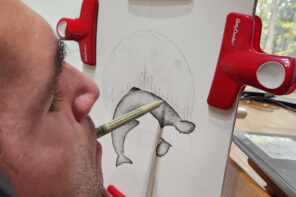Can surfing support development in Africa? It already does.
Excerpted from the book AFROSURF from surf company Mami Wata, adapted for The Surf Issue.
Booming youth populations tend to improve both economies and societies. With 200 million people between 15 and 24, Africa has the world’s youngest population. Internet access is rapidly increasing and poverty rates are falling across the continent. Africa’s future is bright. Against this backdrop, African surf culture offers a unique opportunity for sustainable development, environmental conservation and personal well-being.
The term ‘surfonomics’ was first coined by the organization Save the Waves, an international nonprofit with the mission to protect surf ecosystems across the world. Surfonomics determines the economic value of a wave and surfing to local communities, to help decision-makers protect their coastal resources.

It’s a concept that is particularly relevant to understanding the potential of surfing as a framework for growth in Africa. Evidence shows that localities with quality surf breaks tend to develop between 3-5% faster than the country’s growth rate. Ideally, this financial momentum should improve living standards and quality of life, while safeguarding the local environment. But how?
“Surfing is a non-extractive coastal resource,” says Save the Waves executive director Nik Strong-Cvetich. “As long as the environment is protected, a surfing wave is a completely renewable resource.”
It’s about transforming the beach into a shared community space.
—Tim Conibear
Imagine a wave. World-class. Now imagine a surfer who spends $150 per day to visit, and is likely to hang out for 30% longer than the average tourist. You don’t need big numbers to make it work. With just 100 surf tourists at any one time, for eight months of the year, the waves create a $3.6 million dollar influx of capital per year.
But don’t get swept up in the dollar signs. While the cash is an essential ingredient for growth and development, money alone doesn’t automatically translate into sustainability, environmental safeguards or social benefit.

“Local ownership is the best model for long-term sustainability,” says Strong-Cvetich.
Central to the concept of surfonomics in Africa, or Afrosurfonomics as we like to call it, is the recognition that surfing benefits people beyond the tourist dollars that quality waves attract. Local surfers, invested in the simple act of riding waves for their own enjoyment, are often more than just active participants in surf culture, but stewards and custodians of their local breaks.
Grassroots surf therapy organizations such as Waves for Change (which runs programs in South Africa and Liberia, and supports others all over Africa and the world through the Wave Alliance) can create the cornerstone for broader surf development. Daily programs revolving around mental health and well-being improve the health of a community, teach local people to surf, and create surf coaching opportunities for local and international visitors. Around this, people set up kiosks offering food and drink. Surfing, in this context, acts as a microeconomic generator in the society.
Money alone doesn’t automatically translate into sustainability, environmental safeguards or social benefit.
As Tim Conibear from Waves for Change says, “It’s about transforming the beach into a shared community space.”
“Tourism alone can be super damaging,” says Nik Strong-Cvetich from Save the Waves. “Communities shouldn’t be entirely reliant on tourism because of the booms and busts. If an area gets over-promoted it can damage both the community and the ecosystem. It brings in a lot of drugs, crime, prostitution and the kind of travelers who seek that.”

Save the Waves have defined three key ingredients required to protect a surf ecosystem:
1) A mobilized local constituency.
2) Legal protection of the area.
3) Effective stewardship to combat pollution, water quality, trash, and erosion.
When you protect that quality surf break, you also protect the other components of the ecosystem, like coral reefs and mangroves. These break the wave action up, reduce erosion and reduce the impact of climate change-related coastal flooding. If you’re protecting your coastline then you’re going to protect the other things that people could be dependent on, like local fisheries.

The Motherland has an abundance of natural resources and a long history of colonial exploitation and extraction that have left parts of the world’s richest continent poor and conflicted. Ideally, Afrosurfonomics is a concept that puts the destiny of Africa’s unspoiled coastlines in the hands of the dynamic, young population increasingly interested in surfing them and asserting themselves in the world.










